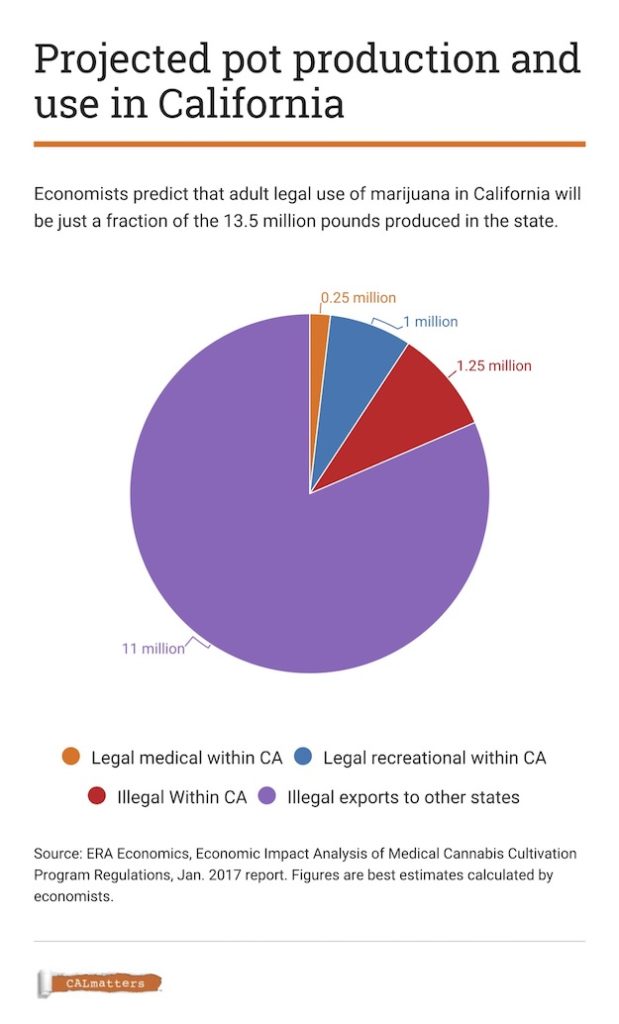Daily Business Report-Aug. 3, 2017
Exactly how much cannabis circulates in California is unknown because most marijuana grows — and purchases — have been illegal for so long.
Despite legalization of Marijuana,
California’s Black Market
Could Remain Huge
By Laurel Rosenhall | CALmatters
Legalizing marijuana, California voters were told last year, would create a “safe, legal and comprehensive system” allowing adults to consume the drug while keeping it out of the hands of children. Marijuana would be sold in highly regulated stores, the Proposition 64 campaign promised, and California would gain new tax revenue by bringing the cannabis marketplace “out into the open.”
Voters overwhelmingly bought the message, with 57 percent approving Proposition 64. But as state regulators prepare to begin offering licenses to marijuana businesses on Jan. 1, it turns out that a huge portion of the state’s weed is likely to remain on the black market.

That’s because California grows a lot more pot than its residents consume, and Prop. 64 only makes marijuana legal within the state’s borders. It also didn’t give an automatic seal of approval to every cannabis grower. Those who want to sell legally must be licensed by the state and comply with detailed rules that require testing plants, labeling packages and tracking marijuana as it moves from farm to bong.
Exactly how much cannabis circulates in California is unknown because most marijuana grows — and purchases — have been illegal for so long. But economists hired by the state government estimate that California farms produce about 13.5 million pounds of cannabis each year, while state residents annually consume about 2.5 million pounds. That leaves 11 million pounds of pot that likely flows out of California illegally, according to the
economic report commissioned by the California Department of Food and Agriculture, which regulates cannabis farmers. Other analyses have similarly found that roughly 80 percent of California-grown marijuana leaves the state.
Even the 2.5 million pounds of marijuana consumed within California won’t all be purchased through state-sanctioned shops when they open; the economists predict about half of it will probably be sold illegally.
“Those sales opportunities will still be there,” said Hezekiah Allen, executive director of the California Growers Association, which represents more than 1,000 marijuana businesses in the state.
Allen surveyed his members recently and found that 85 percent hope to get a license to sell marijuana legally under Prop. 64. But many fear they won’t be able to because some local governments will limit or ban pot businesses, or because prices could drop too low in the regulated market. And if they can’t sell weed legally, 40 percent of the respondents to Allen’s survey said they would continue operating the way they always have: on the black market.
Some long-time cannabis growers will likely go out of business, Allen said. But, “at the end of the day, a lot of businesses in general may stay outside of the regulated market.”
That means that despite the passage of Prop. 64, California cops will still have plenty of work going after illicit cannabis operations.
“You’re going to see robust enforcement efforts to prevent California from becoming the staging area for drug trafficking nationwide,” said John Lovell, a lobbyist for the California Narcotics Officers Association, which opposed the ballot measure.
A spokesman for the Prop. 64 campaign said the measure wasn’t intended to abolish all criminalization of marijuana but instead to allow opportunities for “operators who want to be responsible and compliant.”
“No one ever promised to completely eliminate the black market—that’s like promising security cameras will completely eliminate shoplifting — but it will be significantly reduced,” spokesman Jason Kinney said by email.
He added that the state’s estimates of marijuana supply and demand are unreliable because the legal marketplace created by Prop. 64 won’t begin to roll out until next year. And he pointed out that some of the tax dollars generated by legal marijuana sales will go toward cracking down on illicit operations.
State officials said they are encouraging marijuana businesses to follow the rules and become part of the regulated system, while also planning how to go after those that remain in the black market.
“We are developing a formal complaint system that will allow anyone to report illegal grows or other concerns, and then we will forward those potential issues to the appropriate (law enforcement) agencies,” said Rebecca Forée, a spokeswoman for the state’s cannabis cultivation licensing office within the Department of Food and Agriculture.
Lori Ajax, chief of the state’s Bureau of Cannabis Control, said her agency is trying to entice marijuana businesses to go legit by crafting rules that aren’t too difficult for them to live by.
“It’s making sure those people who want to be in the regulated market, that we have made a path for them, we’re not making our regulations so difficult and hard to comply with that you’re discouraging people,” Ajax said.
“First, we’ve got to get those folks in there and… then see what comes after that with enforcement.”
CALmatters.org is a nonprofit, nonpartisan media venture explaining California policies and politics.
___________________
NASSCO Breaks Ground on New Panel Line
General Dynamics NASSCO on Wednesday began construction on a new panel line designed to increase efficiencies in the shipbuilding process.
With an output as thin as five millimeters, the new panel line will significantly improve NASSCO’s ability to manufacture all steel structures — especially thin plate — and will double steel processing and production rates, officials said. Thinner plate allows for the design of increasingly cost-effective and fuel-efficient vessels. The new panel line will benefit future shipbuilding programs, including containerships for commercial customer Matson, Inc., and fleet replenishment oilers for the U.S. Navy.
___________________
Naval Base Point Loma
Change of Command

Captain Howard C. Warner III will relinquish command of Naval Base Point Loma to Captain Brien W. Dickson during a “change of command” ceremony at 10 a.m., Friday, at the Naval Base Point Loma USS Roncador submarine memorial.
Warner is retiring from the Navy after 28 years of service. Dickson returns to San Diego from Washington, D.C., where he served in the Pentagon. Dickson had previously served as deputy commander for training on the staff of Commander Submarine Squadron ELEVEN here in San Diego.
Naval Base Point Loma serves as the home base for more than 19,000 personnel serving the Navy as civilians and active duty.
___________________
ViaSat Gets $19.3M Deal to Provide
In-Flight WiFi to Gov’t VIP Aircraft
Carlsbad satellite Internet provider ViaSat said this week that it has received a $19.3 million contract extension to supply broadband in-flight Wi-Fi to government VIP aircraft. The extension is part of a previously announced $73 million contract that ViaSat won last year from the United States States Defense Information Systems Agency. In addition to in-flight connectivity, the contract also includes cybersecurity services. —San Diego Union-Tribune
___________________
UC San Diego Researchers Join Fight
Against Disease-Transmitting Mosquitos
University of California San Diego scientists have been selected by The Defense Advanced Research Projects Agency (DARPA) to be part of a “Safe Genes” research team that will receive up to $14.9 million to study an innovative genetic research technique as a way to control disease-causing mosquitoes.
Led by UC Riverside’s Omar Akbari, assistant professor of entomology, the project will focus on a technique known as gene drive, which can spread desirable genes in wild populations and suppress harmful organisms.
The researchers want to understand the potential risks and benefits of using gene drives to control mosquitos that carry diseases including Zika, chikungunya, dengue and yellow fever.
___________________
Salk Lab Part of New Effort to
Advance Studies of the Brain
The University of Texas at Austin, Salk Institute and the Texas Advanced Computing Center (TACC), have received a grant of over $9 million from the National Science Foundation to unravel details of the brain, in particular by mapping connections called synapses. Led by UT Austin, the project will model synapse function and share the data publicly for use by scientists throughout the world.
___________________
Valentine Hoy Elected President of
Employee Retirement System Board

The San Diego City Employees’ Retirement System (SDCERS) Board of Administration has elected Allen Matkins partner Valentine S. Hoy to serve as board president. Appointed to the board by former Mayor Jerry Sanders in 2011, Hoy served as chair of the board’s Business and Governance Committee for the past two years and as vice president of the board for the past year. He succeeds Alan Arrollado, who held the position of board president for the past two years. Hoy previously served as a trustee and board president of the San Diego Museum of Man.
SDCERS administers benefit plans for the city of San Diego, the San Diego Unified Port District and the San Diego County Regional Airport Authority and provides service retirement, disability retirement, death and survivor benefits to more than 20,800 members.




